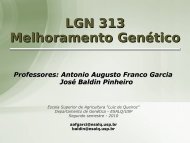diversidade de nematoides em sistemas de culturas e ... - Index of
diversidade de nematoides em sistemas de culturas e ... - Index of
diversidade de nematoides em sistemas de culturas e ... - Index of
Create successful ePaper yourself
Turn your PDF publications into a flip-book with our unique Google optimized e-Paper software.
43(sist<strong>em</strong>a <strong>de</strong> s<strong>em</strong>eadura direta e uso <strong>de</strong> cruzador, <strong>de</strong> forma isolada ou conjunta) e amaior dominância foi observada nas áreas manejadas com arado <strong>de</strong> discos,principalmente <strong>em</strong> sucessão soja/trigo. N<strong>em</strong>atoi<strong>de</strong>s da família Cricon<strong>em</strong>atida<strong>em</strong>ostraram-se eficientes <strong>em</strong> diferenciar sist<strong>em</strong>as agrícolas <strong>de</strong> nativos e a famíliaDorylaimidae possibilitou a diferenciação entre rotação e sucessão <strong>de</strong> <strong>culturas</strong>.Palavras-chave: Bio<strong>diversida<strong>de</strong></strong> <strong>de</strong> solos. Comunida<strong>de</strong>s <strong>de</strong> n<strong>em</strong>atoi<strong>de</strong>s.Cricon<strong>em</strong>atidae. Dorylaimidae. N<strong>em</strong>atoi<strong>de</strong>s <strong>de</strong> vida livre. N<strong>em</strong>atoi<strong>de</strong>s parasitas <strong>de</strong>plantas.ABSTRACTN<strong>em</strong>ato<strong>de</strong>s are the most abundant metazoans on the planet and <strong>de</strong>velop in variousecosyst<strong>em</strong>s, including freshwater, marine water or soil. Edaphic n<strong>em</strong>ato<strong>de</strong>s playimportant roles in soil and ecological processes and are sensitive to humanintervention and agricultural practices, and can be usefull as biological indicators.Thus, this study aimed to evaluate the effects <strong>of</strong> cropping and soil manag<strong>em</strong>entsyst<strong>em</strong>s on n<strong>em</strong>ato<strong>de</strong> diversity in communities and to establish impact levels <strong>of</strong> theagricultural practices adopted. For this purpose, soil samples were taken in areassubjected to two cropping syst<strong>em</strong>s (succession soybean/wheat and crop rotation)and five syst<strong>em</strong>s <strong>of</strong> soil manag<strong>em</strong>ent (no-tillage, conventional tillage with disk plow,gra<strong>de</strong> heavy cruiser and no-tillage with cruiser every three years), belonging to along-term experiment at the experimental area <strong>of</strong> Embrapa Soja, Londrina-PR. Thechosen <strong>de</strong>sign was a randomized block in a factorial (2 x 5) + 1, with fourreplications. Were also analyzed an area <strong>of</strong> native vegetation (forest) as a referencefor ecological balance. The soil samples were taken in 2011, collecting every 0.10 min <strong>de</strong>pth from 0.0 to 0.30 m, with subsequent extraction <strong>of</strong> n<strong>em</strong>ato<strong>de</strong>s in consecutivesieves and clarification by centrifugal flotation in sucrose solution. After counting andi<strong>de</strong>ntification <strong>of</strong> n<strong>em</strong>ato<strong>de</strong>s in the genus level, communities were characterizedaccording to their abundances (total and relative) and diversity (number <strong>of</strong> genera,H', J', SR and DS). The data were submitted to ANOVA and Tukey test at 5%significance level in or<strong>de</strong>r to i<strong>de</strong>ntify the effects <strong>of</strong> cropping syst<strong>em</strong>s andmanag<strong>em</strong>ent (alone or jointly) on the n<strong>em</strong>ato<strong>de</strong> communities. The highest









